Isa Mazzei and Daniel Goldhaber discuss their debut Cam (2018)
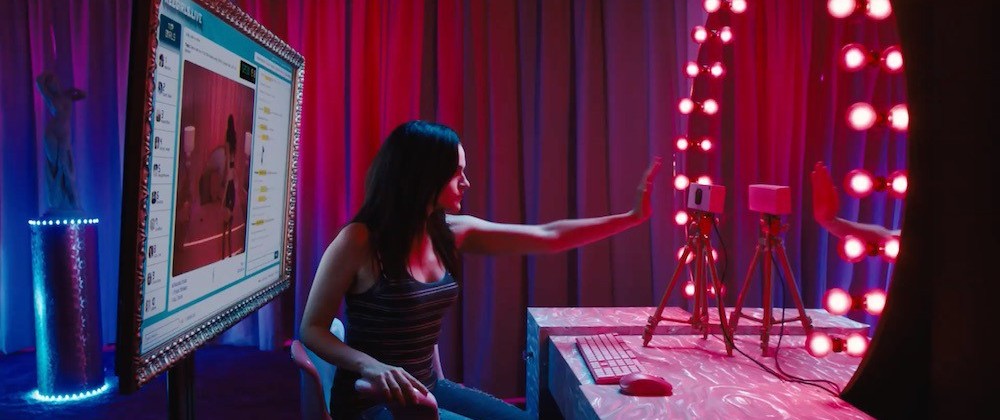
One of the most discussed films at Montreal’s Fantasia Film Festival 2018 was Isa Mazzei and Daniel Goldhaber’s Cam (2018). The film’s impact on contemporary film culture didn’t stop at Fantasia. Cam premiered across USA and in the UK, had a run at the Alamo Drafthouse in Brooklyn, and is now making its debut on Netflix [on November 16, 2018 in Canada]. The cast and crew of the film have also picked up numerous awards along the way.
This psychological thriller follows Alice (Madeleine Brewer) as she tries to track down the doppelganger (also Brewer) that stole her camgirl persona Lola. The film provides a close examination of the camming profession and does so in a very sympathetic light (thanks in part to Mazzei’s prior work in the industry). Additionally, it tackles issues of identity and selfhood in the digital era.
At Fantasia (link) I spoke with Daniel, Isa, and actor Patch Darragh about the film’s narrative, camming, and sexual representation. Our engaging interview led to a subsequent Skype chat about filmmaking techniques, production design, performance, and the exceptional poster art.
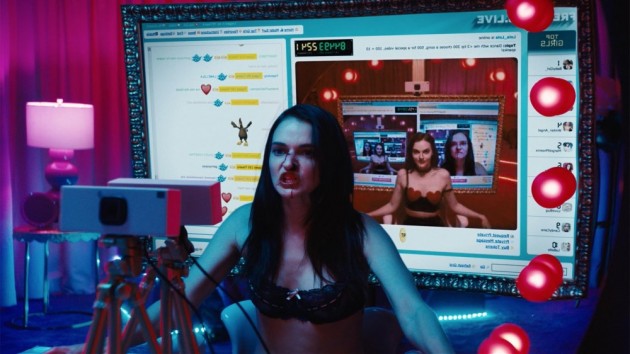
Offscreen: Cam was a huge success at Fantasia. Isa won the Cheval Noir award for Best Screenplay and the crew won the New Flesh Award for Best First Feature. I imagine you’re both extremely satisfied with the response to the film. What were your expectations going into the Fantasia premiere?
Mazzei: I don’t think we had any expectations. I was just really excited to show the film to an audience. We sold out both our screenings – even that was incredible and awesome. It seemed like everyone at Fantasia was talking about our movie, which was crazy – it blew my mind.
Offscreen: I got that sense too.
Mazzei: To win an award at the end of that was really incredible too. I think there’s a picture of us on Instagram when we were told – we were shocked and so happy.
Goldhaber: The New Flesh Award for me and the rest of the crew was incredibly satisfying. This was such a first feature across the board. Cam was almost every crew member’s first narrative film. It was something Isa and I had always wanted to do on some level because we had a certain energy behind us and you can feel that in the movie. It was nice, then, to be recognized for our efforts by some really cool judges.
Offscreen: Daniel, Cam was your first feature film, but you had some filmmaking experience prior to it.
Goldhaber: I went to Harvard and graduated from the Department of Visual and Environmental Studies. It’s a very strange and different kind of film school. It’s very small. They have no narrative film department, so it’s mostly documentary and experimental film. It’s a different kind of pedagogy that focuses on talking about and figuring out how images have value and how to create images that are meaningful. I made a couple of films there, then I did commercial work after I graduated, and a lot of writing, branding and consulting work until we got Cam off the ground.
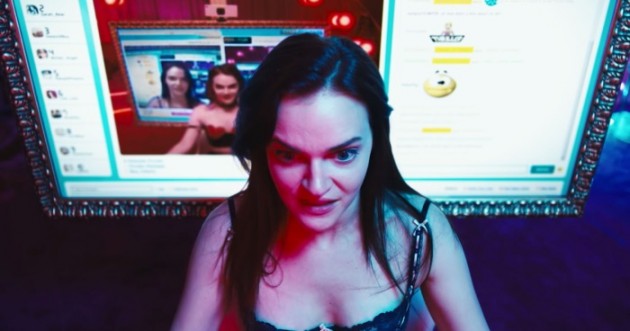
Offscreen: One of the most technical parts of the film is the chatroom. Tell me about making the chatroom, a key component of the camgirl experience. You had to create this fictional space, FreeGirls.Live, based on real online spaces.
Goldhaber: Shout out to Isabelle [Link-Levy], our producer, who is the website. She put the pictures up on the website, ran the website… Early on we knew that we wanted to shoot with as many live, non-digitally composited monitors as possible, and to make the performance feel authentic. To get the eyelines right, get the rhythms right, we needed to have a live website that wasn’t even pre-recorded but that Madeline [Brewer] was able to interact with. We found this company in Brooklyn called CHIPS and the lead designer is Tate Blanks, who is amazing. They built a fully functional site. Isa and Isabelle spent months scripting it, adding emojis…
Mazzei: All the men have their own characters, own inside jokes. If you pause the movie you can track them. We wanted Madeline to engage with real people, real characters that she would garner affection for, just like the real experience.
Goldhaber: That was step one, then we got into post-production, and no one had ever cut a movie like this before, or used these kind of assets in a movie before. So we had to ask: how do we generate them, how long do we have to hold on any of these shots, what’s coherent… You change an emoji and the scene changes. So post-production took a solid year of full-time work. It was me, Isabelle, and Dan Garber, the extraordinary editor, in a room together just beating our heads against a wall.
Offscreen: Speaking of editing, the film is almost split into two parts: everything seems to be going well for Alice then she wakes up to find the world has been turned upside down. The cinematography and editing really captures Alice’s world spinning out of control. I’m specifically thinking of her brother’s birthday party, where the film drastically shifts its tone from a mystery to psychological horror. There’s an abrupt cut to this new sequence, there’s a handheld or Steadicam that follows her around the party, and there’s this incredible tension there. How did you create tension with cinematography and editing, and for this sequence in particular?
Goldhaber: I love that shot [of the birthday party]. It’s a two and a half minute single take that somewhat came out of a production constraint. We had to figure out how to set up many characters quickly, manage all these different people while keeping the tension. We actually had three or four shots for that, then on the day, being in the location, I realized that we’re going to do it in a long take. We blocked and shot in four hours. And I love it.
In general, the birthday party scene was probably the hardest scene to edit. It was originally a lot longer. Alice gets into a big conversation with her brother and her mom. It worked on the page really well. Then in the editing process, we realized we could work better with silence, with these glances and gestures. You could see everything you needed to in these characters’ performances.
Offscreen: The final showdown between the digital Lola and the real Lola must have been difficult to shoot and edit too. You have mirrors and screens, reflections of both. How did that work?
Mazzei: Before we get into the technical aspects of it, I just want to state how Daniel came up with it. We knew we wanted this epic showdown between the Lolas. Daniel and I were sitting in a cafe with piles of scattered paper trying to figure out the mechanics of how this would work onscreen, how to get that infinity effect and the monkey-see monkey-do aspect. I remember Daniel cracked it. I didn’t quite understand how it worked but he said to just write it. To watch him then make that happen was incredible.
Goldhaber: We had to get Alice back on the camsite to have a showdown with her antagonist. Heading into production, we built a whole setup in our production office to test it, to see if it made sense. We did that and we saw that it worked. The shooting of it wasn’t that hard. [DP] Kate[lin Arizmendi] and I had a very specific shot list developed.
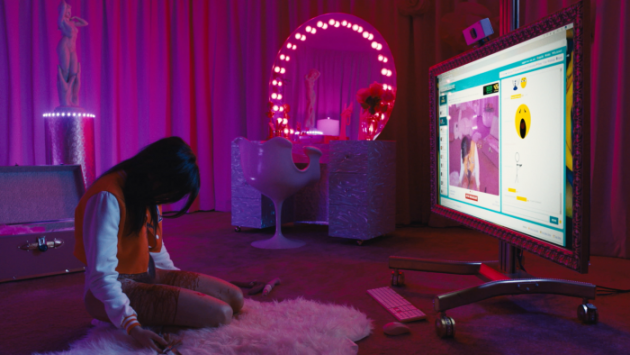
Shooting other scenes in the pink room [Alice’s camgirl set] were much harder than the climax because there was so much less going on. When Alice is just sitting there watching something, and you’re trying to create an action sequence out of that, was really tough.
What became impossible with the climax was the post-production. It is six and a half minutes of visual effects. In normal cam use, there are lags between the user and their webcam, the image and the receiver. What sells the scene are the lags, the different Lolas and Alices out of sync with each other. That was a late breaking thing in the edit.
The other thing to keep in mind is that we had to cut that scene three times. We had to cut Alice in the real world, the Alice webcam performance, and the Lola webcam performance. It was a real monster. We had no idea if it was going to work until the very end of the edit, until the final sound mix.
Offscreen: It does work and looks fantastic. You mentioned working on a tight budget. One of the things I really like about the film is the sets – they look quite authentic. Who was responsible for the sets, particularly the pink room? Is that room representative of camgirl aesthetics or sets that they would have, or is this something unique to Alice’s character?
Mazzei: Emma Rose Mead was our production designer. She absolutely killed it. Most camgirls do have their own space; they have their own camrooms that they decorate as an expression of themselves to varying degrees of intricacy. For Alice, we wanted her space to be the next level. We wanted it to be exaggerated, a fantasy space; we wanted to give it a lot of color, we wanted it to feel rich and interesting. Daniel pulled a lot of visual references for that and Emma just ran with it. She came up with the idea of having a big circular room.
Goldhaber: One of my big references was James Bidgood’s Pink Narcissus [1971]. It was his only feature film. It’s a gay film that was perhaps commissioned as a porno, but he transformed it into a phantasmagoria of the gay experience. A huge centerpiece of the movie is this pink room that the main character is in. I loved the movie aesthetically and it had been a reference, but it became an even bigger reference when I learned about the production history – porn as self-expression.
So Alice’s pink room is an expressionistic version of a camgirl room, but also a version that represents what camming means to her. She sees camming in her own space as this
incredible means of self-expression. In the beginning, the pink room is very vibrant; when she loses her account it gets very…
Mazzei: The real world starts to bleed into it. We see pieces from her real room, the take-out containers, blankets that don’t really match.
Goldhaber: When we go back in for the climax and she’s got a plan, all of a sudden the room comes back alive.
Offscreen: Because of the care that went into production, Cam is sympathetic to sex workers and the tone seems to help with Madeline Brewer’s performance, which was stellar. What were her thoughts going into this film and playing as a character with two identities? Isa, did you work closely with her in terms of helping her understand the career and performances?
Mazzei: Absolutely. I met Madeline before she came in to read. We sat down and got coffee and we talked in broad strokes about the politics of the film, the ideology, what we were trying to do, and a little bit about what I was trying to bring into the story via my own identity and relationship to this digital world. She was fascinated by it.
We later went to do a read-through at her house and she had an annotated script in the binder indicating where she is Alice, Alice as Lola, as Lola not as Alice but as Alice performing Lola in the real world for Barney. There are all these different facets of performance and performative femininity that are exaggerated in this online world. Madeline really just captured that.
We watched some camgirls. I showed her some girls that I liked. She really took the initiative to distinguish these different aspects of the character for herself. I was impressed.
Offscreen: Alice is placed in a number of vulnerable situations. What measures were taken to ensure Brewer’s comfort with the nude scenes?
Goldhaber: Isa and I told Madeline that if there’s nudity in the movie, we wanted her to be the author of that. Even if it’s in the script, on the day of the shoot, it was up to her. She got to this place where she understood the character better than we did. With particular scenes, she approached us and said, “I feel like this has to be totally naked.” In other scenes, Madeline said the nudity will be distracting – it didn’t feel like Alice would go to that place. Heading into the edit, she was right 100% of the time. It really helps with that feeling of Alice as in control and empowered by her body. Isa also directed some scenes of the movie, so that is a significant component of fostering Madeline’s comfort.
Mazzei: Some of the more sensitive scenes, such as the Vibratron scene, I was the one directing, because of my first-hand experience of something similar, and also to ensure that Madeline had me there to help her if she needed it or to provide reassurance. It was important to us to not have gratuitous sexuality – the nudity and sex had to be thematically relevant. Madeline really engaged us in those conversations. She had the instincts of how to do the character. Some of the more technical aspects – from spanking, to where to look, or what it’s like to do a camshow with another girl – Madeline was so excited to learn those little details, and it added so much authenticity to her performance.
Offscreen: I want to ask about Lola’s niche as a performer. She caters to heterosexual men and the film is largely about heterosexuality. My understanding is that in private chats (link), men sometimes want less conventional sexual experiences, particularly sadomasochism, emasculation, and bisexuality. More rarely, women browse camming sites. In our previous discussion, someone mentioned that you wanted the film to reach a wide audience. Did you leave out more robust depictions of sexuality for that reason? Is Cam the first step towards future fiction films which can go further into the diversity of cam performers and their fans?
Mazzei: Absolutely. For Alice, we drew a lot from my own experience, which was performing primarily for heterosexual men. I went a little further into kink than Alice, but this is her story. We tried to stay true to that: who her viewers would be, who she would be interacting with, what kind of messages they would be sending her.
What we tried to do with the camgirl montage [partway through the film] was bring in more body types, different types of women, different types of performance. We have some light BDSM in there. We really did want to have
this colorful montage that showed a wide variety of performers on this site and Alice is just one of many performance types. There is type of ideal woman, no ideal type of sexuality; what’s so cool about camming is that it can cater to anyone’s tastes and desires. It was important to us to have an accessible film but also hint that there is more here. Hopefully by having someone empathize with Alice’s vanilla experience of camming, it will open the door for other people to explore aspects of kink, fetish and sexual expression within mainstream film.
Goldhaber: That’s stuff we’re planning on diving into in the future. In many ways the movie is about performance, performative sexuality. In our research leading up to the film, what we heard in conversation with sex workers was that sex work is performance on so many levels. Gender is performance, whether or not you’re a sex worker; sexuality is a performance, whether or not you’re a sex worker. That was the aspect we were interested in. So that’s what we focus on in the movie. That was one of the reasons why we didn’t make a documentary; it’s hard to do something about pornography without making pornography.
Mazzei: Not that there’s anything wrong with pornography – we love pornography.
Offscreen: It would just be a different project.
Goldhaber: It’s about the theatrical release, about having something that is about porn without being porn. It’s getting people to understand the psychology of someone who makes pornography.
Offscreen: My last question is about the fabulous poster. Who designed it? It has this great Cronenberg or Lynchian aesthetic.
Goldhaber: I met Charlotte Gosch (link) through a friend. She designs the covers for Filmmaker Magazine. We had a very limited budget for the poster. She had really good ideas, so I told her to design whatever she wanted, and I’d give her some notes. I told her to make it a piece of art for herself. The poster is amazing.
Mazzei: We love it so much. I screamed when I saw it.



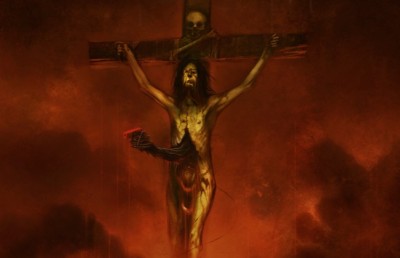

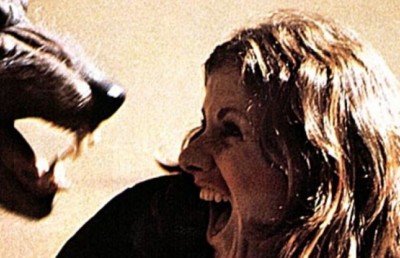
_400_258_90_s_c1.jpg)







